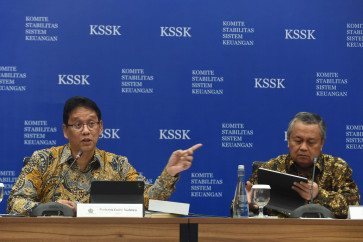Popular Reads
Top Results
Can't find what you're looking for?
View all search resultsPopular Reads
Top Results
Can't find what you're looking for?
View all search resultsJava deforestation continues, threatens endangered animals
The pace of deforestation in Java from 2007 to 2010 has reached 10,000 hectares and has become a serious threat to people and protected wildlife on the island
Change text size
Gift Premium Articles
to Anyone
T
he pace of deforestation in Java from 2007 to 2010 has reached 10,000 hectares and has become a serious threat to people and protected wildlife on the island. East Java is recorded as the biggest contributor to deforestation in Java, at a rate of 438.1 hectares annually.
ProFauna Indonesia campaign officer Radius Nursidi said recently the actual pace of deforestation is believed to be higher than the data issued by the government. The deforestation rate of 10,000 hectares is based on data issued by the Forestry Ministry and took place from 2003 to 2006. The deforestation rate in Java is recorded at 2,500 hectares annually, or 0.2 percent of Indonesia’s total, which is 1.17 million hectares annually.
Although Java is ranked fourth after Sumatra, Kalimantan and Sulawesi in terms of deforestation levels, the remaining forested areas in Java are vital because Java is home to many rare and endemic wildlife species threatened with extinction, while the forest, as the protected animals’ habitat, has not been well preserved.
“The current situation could pose a serious threat to people and rare animal species in Java, such as the Javan hawk eagle [Spizaetus bartels], silvery gibbon [Hylobates moloch], Javan langur [Trachypithecus auratus], Sunda slow loris [Nycticebus coucang], Javan surili [Presbytis comata], Javan rhinoceros [Sunda rhinoceros] and other endemic animals,” Radius said.
The government should take practical and political measures to protect the remaining forest and wildlife in Java. It should set up security posts at the entrances to natural conservation areas.
At present, Nursidi said, “people can enter and leave the natural conservation areas easily, including wildlife poachers”.
Forest conversion in Java has a direct impact on widespread poaching, especially in East Java.
ProFauna observations show wildlife poaching and illegal logging are still taking place on a regular basis in areas, such as the R. Soerjo Grand Forest Park in Pasuruan and Merubetiri National Park in Banyuwangi, due to lax supervision by authorities and ease of access.
ProFauna’s latest survey of 70 bird markets in 58 cities nationwide in 2009, found at least 183 protected animals being traded freely. “And the province trading the largest number of protected animals is East Java,” ProFauna Indonesia chairman Rosek Nursahid said. Generally, the trade in protected animals at major bird markets, such as in Surabaya and Jakarta is done covertly, with animals not displayed openly but secretly, in traders’ storehouses or homes, and shown only to prospective buyers.
Rosek said the wildlife trade issue should be made a national issue because it violated the 1990 law on the conservation of biological natural resources and their ecosystem. The law stipulates that violators involved in the illegal trade of wildlife species can face a 5-year prison sentence and be fined Rp 100 million (about US$10,000). “Despite the law protecting wildlife from illegal trading, in practice the trade is still going on in many places in Indonesia,” said Rosek.










